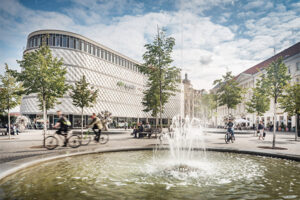BY NEIL HOCKIN
Being a geographically small country with strong transport links, consumers are prepared to travel to regionally dominant destinations where they are able to enjoy a full retail experience. This, combined with increasing competition from the internet, has left many shopping center owners having to review their strategies in order to keep up with competition and capture consumer interest. What is required in order to stay on top?
The impact of the internet on retail is one of the most widely discussed topics of recent years and something that continues to be on the agenda for landlords and asset managers. Retailers are looking at how they interact with their consumers and it is refreshing to see that the best retailers are becoming the best e-tailers. This encourages a dual shop, with consumers able to pick up or return goods in store, allowing retailers to try to upsell to them. As an industry, we must learn from retailers and look at how to merge the lines between clicks and bricks while protecting core lines of income. Facilities like Amazon Buy-Box and click and collect help with this and should be considered part of the asset management process. Thought needs to be given so that these “bolt-ons” add to the whole consumer experience and drive footfall throughout the asset. Just installing a click-and-collect facility in the most convenient location in a car park might not be the best long-term solution.
With the dominance of regional centers and resurgence of city centers, smaller shopping centers need to adapt, both physically and from a deal structure perspective, to ensure high occupancy rates from the retailers that consumers like. To that end, MSU operators such as Next, H&M, and Primark are largely able to dictate their own terms. This is particularly the case in secondary and tertiary centers, where space is not necessarily at a premium and the knock-on implication for landlords can be significant. Landlords have to be more creative and turnover related leases, often with rental caps and significant contributions towards shop fit, are all part of the deal.
Similarly, when designing new space, we must create large flagship stores with prominent frontages that allow these retailers to incorporate a full merchandise mix. To piece together this sort of space from existing units can be difficult and costly and, in many cases, book values have to have diminished significantly. Landlords must take a strategic view in these instances and recognize that the short-term sacrifices in rental income are part of a longer-term vision for the center.
A varied leisure offer continues to provide a solution and the addition of catering space allied to other leisure anchors such as cinemas, indoor golf, and increasingly more creative uses such as trampolines and ping pong, helps to improve dwell time. These also help to attract a broader range of consumers, particularly from the family market, further adding to the vibrancy of a scheme. These uses also generate additional car parking revenue and allow retailers to benefit from increased footfall and dwell time without cannibalizing core fashion spend.
Increasingly, pop-ups and temporary lets are becoming the norm and can help to ensure that consumers are given the impression of a full and vibrant scheme. However, the reality is that this isn’t a long-term solution and it needs to be part of a holistic vision for the scheme’s tenant mix. Equally, established retailers paying full rent on a long-term lease are likely to be less than enamored when a temporary let covering rates and service charges sells comparable products only during peak trading seasons.
The majority of consumers are still driven by recognized brands that appeal to a price point that suits their aspirations. The best retailers are now adept at providing stock ranges across a range of prices that are well suited to their target customers. It is hard for independent retailers to compete with this and, even in some of the quirkier locations in London that have thrived on independent retail, national and international brands are becoming more prevalent.
While the lack of diversity this can create is worrying, consumers vote with their feet (or at least their credit cards) and are attracted to national and international brands, as demonstrated in their turnover levels. These are the operators that drive footfall and improve investment value and will nearly always be the key target for most landlords. Of course there are exceptions to this and certain locations have other criteria; whether it be based on residential or office development, or the need to create something different that cannot always be achieved by relying purely on mainstream retailers.
The one key lesson over the course of the last few years is that there is no one-size-fits-all solution. Retailers look at each individual location differently and so should their landlords – what works for one boutique shopping center will not work for a regionally dominant destination or even secondary community center. The dynamics between different centers, catchments, and parts of the country vary enormously and a prescriptive model does not work. Landlords and their consultants need to be innovative and think laterally to increase footfall and spend, improve tenant mix, and maximize asset value on a case-by-case basis.
What is your opinion on this topic? Discuss it with us! Send your opinion to opinion@across-magazine.com !






